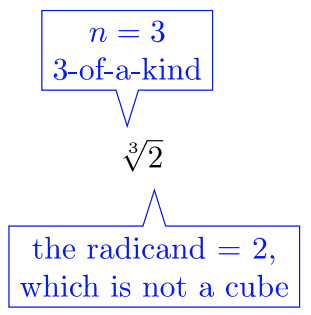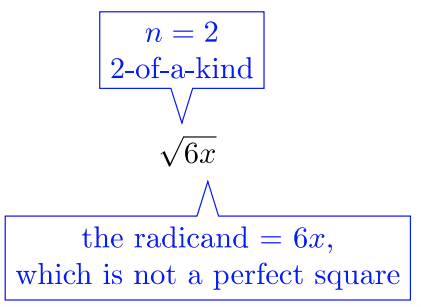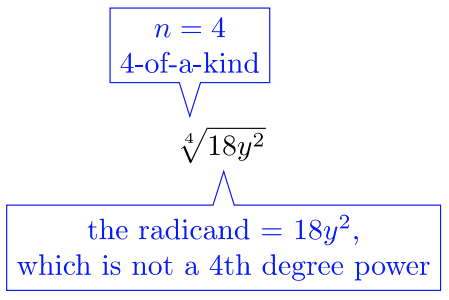6.3: Rationalize Denominators
- Page ID
- 83147
Suppose a fraction \(\dfrac{a}{b}\) contains a radical in the denominator. Rationalizing the denominator is a method of simplification that eliminates radicals from the denominator. The numerator may contain radicals, but we generally don’t worry about that. Only the denominator is rationalized. Sometimes the denominator becomes rational in the simplification steps. Let’s look at the easiest type of problems in the first example.
Simplify the expression.
- \(\dfrac{5}{\sqrt[3]{27}}\)
- \(\sqrt{\dfrac{10}{49}}\)
- \(\sqrt{\dfrac{15}{12}}\)
- \(\dfrac{\sqrt[3]{21}}{\sqrt[3]{24}}\)
Solution
- \(\begin{array} &\dfrac{5}{\sqrt[3]{27}} &= \dfrac{5}{3} &\text{The denominator of the simplified fraction is rational.} \end{array}\)
- \(\begin{array}&\sqrt{\dfrac{10}{49}} &= \dfrac{\sqrt{10}}{\sqrt{49}} &\text{The quotient property isolates the perfect square: \(49\).} \\&=\dfrac{\sqrt{10}}{7} &\text{The denominator of the simplified fraction is rational.} \end{array}\)
- \(\begin{array}&\sqrt{\dfrac{15}{12}} &= \sqrt{\dfrac{3 \cdot 5}{3 \cdot 4}} &\text{The order of operations allow us to reduce \(\dfrac{15}{12}\) in the first step.} \\ &= \sqrt{\dfrac{5}{4}} &\text{Now that the fraction is reduced, we spot the perfect square, \(4\).} \\ &= \dfrac{\sqrt{5}}{\sqrt{4}} &\text{The quotient property isolates the perfect square: \(4\).} \\& = \dfrac{\sqrt{5}}{2} &\text{The denominator of the simplified fraction is rational.} \end{array}\)
- \(\begin{array}&\dfrac{\sqrt[3]{21}}{\sqrt[3]{24}} &= \sqrt[3]{\dfrac{21}{24}} &\text{The quotient property changes the order of operations.} \\ &= \sqrt[3]{\dfrac{3 \cdot 7}{3 \cdot 8}} &\text{The fraction is reducible. Cancel the common factor: \(3\).} \\ &= \sqrt[3]{\dfrac{7}{8}} &\text{Conveniently, the cube is in the denominator.} \\ &= \dfrac{\sqrt[3]{7}}{\sqrt[3]{8}} &\text{The quotient property isolates the cube: 8.} \\&= \dfrac{\sqrt[3]{7}}{2} &\text{The denominator of the simplified fraction is rational.} \end{array}\)
More commonly, simplification will not eliminate the radical from the denominator. That is, we wish to use the property \(\sqrt[n]{a^n} = a\) \((a ≥ 0)\), but the radicand is short a necessary factor or two for that to occur. For problems of this type, we will build the fraction to rationalize the denominator.
Play the Game of “n-of-a-kind.”
The goal is to use the property \(\sqrt[n]{a^n} = a\) \((a ≥ 0)\) to rationalize the denominator. Whatever factors are missing, multiply to top and bottom. Simply build up the denominator (and consequently the numerator) to make it happen.
Simplify \(\dfrac{1}{\sqrt[3]{2}}\) by rationalizing the denominator.
Solution
The denominator is irrational, and no simplification of the radical is immediately evident.

The index of the radical, \(n = 3\), tells us how many of-a-kind we need. The radicand \(= 2\). We have one \(2\) out of the necessary three \(2\)’s to simplify. We need two more \(2\)’s to make \(3\)-of-a-kind.
\(\boxed{2}\underbrace{\textcolor{red}{\boxed{2}\boxed{2}}}_{\text{two more \(2\)'s}}\)
\(\dfrac{1}{\sqrt[3]{2}} \cdot \dfrac{\textcolor{red}{\sqrt[3]{2 \cdot 2}}}{\textcolor{red}{\sqrt[3]{2 \cdot 2}}} = \dfrac{\sqrt[3]{4}}{\sqrt[3]{8}} = \dfrac{\sqrt[3]{4}}{2} \)
Therefore, the given fraction after rationalizing the denominator is equal to \( \dfrac{\sqrt[3]{4}}{2} \).
Simplify \(\dfrac{3}{2 \sqrt{6x}}\) \((x > 0)\), by rationalizing the denominator.
Solution
The denominator contains \(2\sqrt{6x}\), but only \(\sqrt{6x}\) is irrational. Therefore, we’ll only rationalize the square root.

The index of the radical, \(n = 2\), tells us how many of-a-kind we need. The radicand \(= 6x\). We have one \(6x\) out of the necessary two \(6x\)'s to simplify.
\(\boxed{6x}\underbrace{\textcolor{red}{\boxed{6x}}}_{\text{one more \(6x\)}}\)
\(\dfrac{3 \textcolor{red}{\cdot \sqrt{6x}}}{2 \sqrt{6x} \textcolor{red}{\cdot \sqrt{6x}}} = \dfrac{3 \sqrt{6x}}{2 \cdot 6x} = \dfrac{\cancel{3} \sqrt{6x}}{2 \cdot 2 \cdot \cancel{3} \cdot x} = \dfrac{\sqrt{6x}}{4x}\)
Therefore, \(\dfrac{3}{2 \sqrt{6x}} = \dfrac{\sqrt{6x}}{4x}\). The denominator is rationalized.
Simplify \(\dfrac{2 \sqrt[4]{5}}{3 \sqrt[4]{18y^2}}\) \((y > 0)\) by rationalizing the denominator.
Solution
The denominator contains \(3 \sqrt[4]{18y^2}\), but only \(\sqrt[4]{18y^2}\) is irrational. Therefore, we’ll only rationalize the \(4^{\text{th}}\) root.

Take inventory of the factors of the radicand \(18y^2\). We need powers of \(4\) to simplify.
\(\boxed{2}\underbrace{\textcolor{red}{\boxed{2}\boxed{2}\boxed{2}}}_{\text{\(3\) more \(2\)'s}} \boxed{3}\boxed{3} \underbrace{\textcolor{red}{\boxed{3}\boxed{3}}}_{\text{\(2\) more \(3\)'s}} \boxed{y} \boxed{y}\underbrace{\textcolor{red}{\boxed{y}\boxed{y}}}_{\text{\(2\) more \(y\)'s}} \)
\(\begin{array} &\dfrac{2 \sqrt[4]{5}}{3 \sqrt[4]{18y^2}} &= \dfrac{2 \sqrt[4]{5} \textcolor{red}{\cdot \sqrt[4]{2^4 \cdot 3^2 \cdot y^2}} }{3 \sqrt[4]{18y^2} \textcolor{red}{\cdot \sqrt[4]{2^4 \cdot 3^2 \cdot y^2}}} &\text{Multiply necessary factors to numerator and denominator.} \\ &= \dfrac{2 \sqrt[4]{5 \textcolor{red}{\cdot 8 \cdot 9 \cdot y^2} }}{3 \sqrt[4]{18 \textcolor{red}{\cdot 8 \cdot 9 \cdot y^2} \cdot y^2}} &\text{Use the product property of radicals.} \\ &= \dfrac{2 \sqrt[4]{360y^2}}{3 \sqrt[4]{2^4 \cdot 3^4 y^4}} &\text{The denominator’s radicand indicates powers of \(4\).} \\ &= \dfrac{\cancel{2} \sqrt[4]{360y^2}}{3 \cdot \cancel{2} \cdot 3 \cdot y} &\text{Simplify the denominator’s radical. Reduce the fraction.} \\ &= \dfrac{ \sqrt[4]{360y^2}}{9y} &\text{Simplify completely. The denominator is rationalized.} \end{array}\)
Rationalize Using Conjugates
We will borrow from the Special Products Formula (below) to rationalize denominators that involve two terms, where one or both terms contain square roots. Recall from Section 2.3 the multiplication of conjugates results in a difference of squares:
Special Product = Difference of Squares: \((A+B)(A-B) = A^2 - B^2\)
Rationalize the denominator: \(\dfrac{4}{3+\sqrt{x}}\) where \(x ≥ 0\).
Solution
\(\begin{array} &\dfrac{4}{3+\sqrt{x}} &= \dfrac{4 \textcolor{red}{(3 - \sqrt{x})} }{(3+\sqrt{x})\textcolor{red}{(3 - \sqrt{x})}} &\text{Multiply numerator and denominator by the conjugate.} \\ &= \dfrac{12−4\sqrt{x}}{3^2−(\sqrt{x})^2} &\text{Use the Special Products Formula.} \\ &= \dfrac{12−4\sqrt{x}}{9−x} &\text{The denominator is rationalized.} \end{array}\)
Try It! (Exercises)
For 1-30, rationalize the denominator. Assume all variables are nonnegative values. Simplify completely.
- \(\dfrac{1}{\sqrt{36}}\)
- \(\dfrac{6}{\sqrt[3]{64}}\)
- \(\dfrac{10}{\sqrt[4]{16}}\)
- \(\dfrac{\sqrt[3]{4}}{\sqrt[3]{32}}\)
- \(\dfrac{\sqrt{45x}}{\sqrt{5x}}\)
- \(\sqrt{\dfrac{6}{200}}\)
- \(\sqrt[5]{\dfrac{972}{128}}\)
- \(\dfrac{\sqrt[3]{2y^2}}{\sqrt[3]{5}}\)
- \(\dfrac{8t}{\sqrt[3]{4t}}\)
- \(\dfrac{2h}{\sqrt[4]{6h^3}}\)
- \(\dfrac{10}{3\sqrt{5p}}\)
- \(\dfrac{15\sqrt{2w}}{7w \sqrt{5w}}\)
- \(\dfrac{24c \cdot \sqrt[3]{4c}}{3c^2 \cdot \sqrt[3]{6c}}\)
- \(\sqrt[3]{\dfrac{55}{21q^2}}\)
- \(\sqrt[4]{\dfrac{25}{12u^3}}\)
- \(\sqrt[5]{\dfrac{60a^3}{45a^7}}\)
- \(\dfrac{26n \sqrt[4]{5n}}{5 \sqrt[4]{8n^5}}\)
- \(\dfrac{2r}{3 \sqrt{2 \pi r}}\)
- \(\sqrt[3]{\dfrac{2b}{a^2}}\)
- \(\dfrac{54y \sqrt[4]{2x^3}}{\sqrt[4]{27y^2}}\)
- \(-\sqrt{\dfrac{20n^5m^3}{65n^9m^4}}\)
- \(\sqrt[3]{\dfrac{-21}{16x^2y}}\)
- \(\dfrac{−75pq}{\sqrt[5]{-3p^3}}\)
- \(\dfrac{−12uv^2}{5\sqrt{36uv}}\)
- \(\dfrac{9}{x-\sqrt{2}}\)
- \(\dfrac{\sqrt{y}}{1\sqrt{2y}}\)
- \(\dfrac{z+\sqrt{3}}{z−\sqrt{3}}\)
- \(\dfrac{\sqrt{10}−\sqrt{5a}}{\sqrt{2a}} \)
- \(\dfrac{\sqrt{2a}}{\sqrt{10}−\sqrt{5a}}\)
- \(\dfrac{\sqrt{u} - \sqrt{v}}{v - \sqrt{u}}\)
For #31-36, use the order of operations. Rationalize denominators where appropriate.
- \(\dfrac{1}{\sqrt{3}} + \dfrac{\sqrt{3}}{3}\)
- \(16 \cdot \dfrac{1}{\sqrt[3]{2}} + 6\sqrt[3]{4}\)
- \(\dfrac{2−\sqrt{3}}{\sqrt{3}(\sqrt{3} + 4)}\)
- \(\dfrac{3}{4} \left( \dfrac{\sqrt{2}}{3-\sqrt{2}} \right)\)
- \( \left( \dfrac{2 \sqrt[3]{25}}{\sqrt[3]{16}} \right)^3 - \left( \dfrac{5}{\sqrt{2}} \right)^2\)
- \(\left( \dfrac{2}{\sqrt{10}} \right)^4 - \left( \dfrac{1}{\sqrt[3]{10}} \right)^6\)


